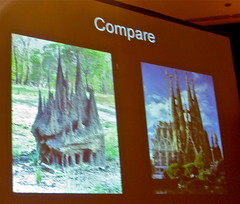Follow the link for some notes, taken by Steve Jurvetson, from a brain spa at the Santa Fe Institute, a weekend symposium on the multi-dimensions of evolution.
For an early taste, check out:
The trickle down theory of creation was “obvious” to people.
The bubble up theory of creation provides one unified perspective, one elegant synoptic model.
Darwin and Turing present a strange inversion of reasoning.
Turing showed that the computer does not need to know what arithmetic is. Computers have competence without comprehension.
Understanding is the effect, not the cause.
Natural selection is an automatic reason-finder. It doesn’t have to know what it is doing. The “Need to Know” principle in the intelligence community has an analog in the biosphere, driven by thrift rather than security.
We attribute more understanding than there needs to be. We lack a familiar conceptualization of semi-understood quasi-representations.
Like life being made of non-living parts, comprehension can be made from non-comprehending parts.
Our brains are more like termite castles than Turing’s computers.
Italian newspaper headline, translated: “Yes we have a soul, but it’s made of lots of tiny robots.”
Branching neurons are descendants of free-swimming organisms.
When running cultural software, brains become minds.
It’s not magic; it’s teamwork.
Words are memes that can be pronounced.
For evolution, you need high-fidelity copying, but it can’t be perfect copying.
The sea shapes the designs of Polynesian boats. If the boat makes it back home, copy it.
Memes are software viruses.
We are the first intelligent designers in the tree of life.
In response to my question about inscrutability of evolved artifacts:
“Yes, reverse engineering the brain may prove infeasible.”
This was Daniel Dennett quoted by Steve Jurvetson

No comments:
Post a Comment